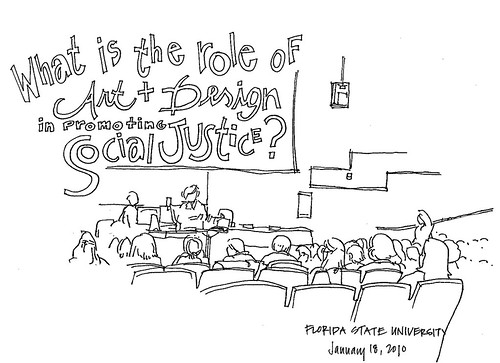
suzanne + patrick presented a talk-about at the
ARTS + DESIGN FOR SOCIAL JUSTICE conference in tallahassee on martin luther king day. with nearly two dozen participants in the session from universities and colleges around the united states, they posed a series of prompts about social justice design projects to which participants. this post summarizes the responses from participants....with gracious thanks to those who attended and participated. in the end, all agreed that the conversations had been valuable...with an email list circulated for us to be in contact...if you'd like to be on that email list, drop us a line and let us know and we'll add you.

one of the most challenging aspects of doing design projects for the community is finding a good partner for student-based projects in a university setting. some of the issues relate to outcomes for the community partner that equate with student learning goals, the actual act of finding the partners, and challenging issues about what designers do and how.
PARTICIPANTS in the session noted that contacts with well known non-profit groups and non-profit consortiums (collectives of groups banded together for some purpose) represented two pathways to likely community partners. importantly, PARTICIPANTS stated that local government resources and the students themselves provided additional avenues for finding both partners + processes. PARTICIPANTS suggested that the strongest projects were those that contained the most emotional connection, with clearly articulated (and desired) outcomes for both students + partners. in the matter of partner participation, PARTICIPANTS identified programming, fundraising, and actual construction/build/installation as key moments where students + community partners come together. PARTICIPANTS identified a challenge in the perceptions of roles + capabilities for both students + partners by each other.
IDENTIFYING FINANCIAL SUPPORT
another obstacle to community-based research and projects falls under the realm of financial support. PARTICIPANTS began their discussion noting university and community resources for key projects on which they worked, noting popular options of trading goods + services, as well as at-cost contract work negotiated with community contractors as ways of reducing overall costs. in identifying ready sources of financial support, PARTICIPANTS suggested that those connected to a social concern or issue were most likely to support it with money and other services. PARTICIPANTS articulated that marketing services and press releases were easy avenues to give credit to financial sponsors, while liability and insurance issues prevailed as the largest challenge in linking partners. with the goal of achieving as much as possible on a limited budget, PARTICIPANTS pointed out that smaller projects in scale sometimes were the most successful approach to community-university collaborations.
GETTING THE WORD OUT

we think that often great projects are overlooked by media sources, and sometimes the universities for which we work. PARTICIPANTS concurred that this was an issue but suggested that being constantly visible, making photographs, pushing students to the forefront, and having an explainable project all were keys to maximizing visibility for community-based work. often PARTICIPANTS suggested that timing of events in the news cycle, having (and using) appropriate contacts at the right time, and succinctly delivering + managing the message were ways to counter some of the challenges.
MANAGING UNIVERSITY RELATIONS

sometimes managing university relations -- in terms of promotion + tenure expectations, getting credit for community-based work, and sharing news of the project internally are the most difficult pieces of a community based project. PARTICIPANTS recognized that many university have vastly different opinions about the value of community-based project, with that low value placed reflecting on the perceptions of students, faculty, and administrators. these projects are often not part and parcel of design department curricula, but PARTICIPANTS suggested that they should be.
MOBILIZING STUDENTS

students are a key factor in the equation to successful projects + outcomes. in identifying student attitudes toward community-based projects, PARTICIPANTS characterized tremendous buy-in and excitement, though some admitted confusion as to what exactly these projects might be. the key factor in success, PARTICIPANTS believed, was in achieving buy-in by making the project personal, reaching the student/designer with the realities of human beings + their lives. in doing so, PARTICIPANTS asserted that students come away with a greater responsibility in design as a social act, thus showing that students often do make a difference in these kinds of community-based approaches.
















































